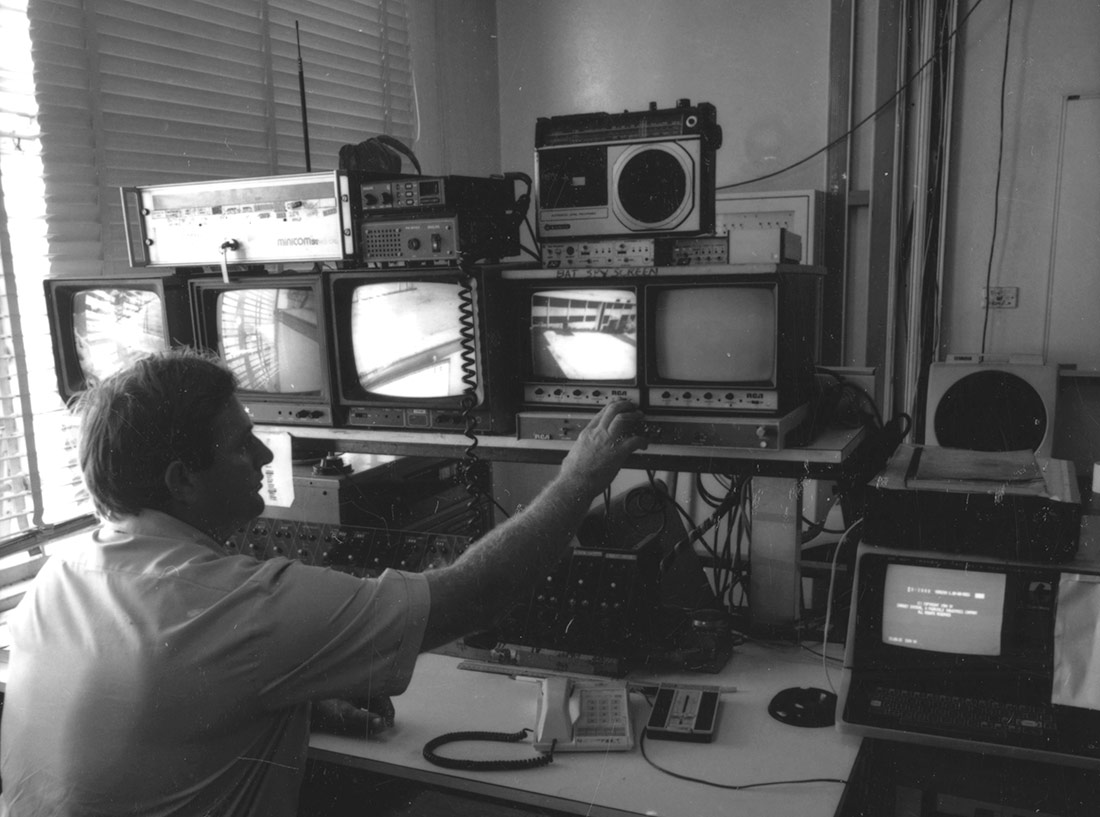
Brisbane Prison Security Station, c. 1988 | Queensland State Archives | CC BY-NC
In a world full of uncertainty, many of us are looking for a safe place where we can live in peace. Aware of this need, the security industry has created platforms and devices aimed at protecting homes and neighbourhoods that, nevertheless, foster a culture of mistrust and social control.
In 2019, the photographer Blanca Munt discovered that her local neighbourhood had a chat group where residents could warn each other of possible burglaries. She lived in Mira-sol, an area of detached houses in Sant Cugat del Vallès, one of Spain’s wealthiest municipalities. After getting her parents to give her access to the group, Munt witnessed how what seemed to be a useful tool for preventing crime and getting to know the neighbours better was actually a channel full of tensions and friction resulting from a combination of fear, suspicion and indignation at what was perceived to be a constant threat to safety. Parts of those conversations are included in the photobook Alerta Mira-sol, shown in the exhibition Suburbia. Building the American Dream.
Halfway between tragedy and farce, Alerta Mira-sol reflects the concept of ‘disturbia,’ which refers to the anxieties of the inhabitants of big-city suburbs. Coined in 1960 by the psychologists Richard and Katherine Gordon, the term reflects the fear of people breaking into the home – whether vandals, burglars or serial killers – that has been so extensively exploited in American fiction. A fear that, however, is implicit in the suburban lifestyle, which lends itself to identical houses inhabited by families all similar in age, income and lifestyle, and in which the notion of “otherness” is clearly defined.
The fact is that moving away from city centres does not solve the problem of safety. As the journalist Jorge Dioni López points out in La España de las piscinas, “Walls do not create peace of mind, but anxiety. The stronger the desire for order and tranquillity, the more things seem ambiguous and, therefore, potentially dangerous. There can never be enough walls.”
From neighbours to vigilantes
WhatsApp groups – a necessary evil that cover the most diverse range of areas – are useful for solving day-to-day problems in a neighbourhood. In the specific case of security, however, they can generate conversations that lead in an uncertain direction. “Could my neighbours be violent?” worries Blanca Munt when she reads some of the messages encouraging people to attack intruders in Mira-sol. Chats like the ones described in her photobook channel atavistic concerns that are very difficult to manage and which can easily lead to intolerance and hysteria.
The phenomenon of neighbourhood organisation to combat insecurity is not new. It could be framed within a series of practices that were born in the United States in the 1960s and that came to be called “neighbourhood watch,” a crime-prevention strategy in which the community itself takes an active role in protecting its neighbourhood, alerting the police to the presence of any suspicious person or activity. Although the nature of these practices depends very much on the specific context in which they emerge, they are, by definition, problematic, as to some degree they appropriate a coercive function that belongs to the forces of the state.
From an ideological point of view, this practice is based on the ultra-liberal belief that not only does the individual not benefit from the state, but that, to a certain extent, they are restricted by the state. Its staunchest advocates argue that it is necessary to “take back” certain powers and responsibilities that have been stolen from them, including the right to ensure their own safety. This philosophy can be put into practice in a variety of ways, ranging from neighbourhood committees that share information and recommendations, to the hiring of private security, to the organisation of neighbourhood patrols. The last of these are particularly controversial because they are a very tangible way of visibilising hostility towards anything different or unknown, which often makes them attractive to xenophobic and extreme-right-wing groups.
The ring of safety
The tradition of community policing in the United States has evolved technologically beyond WhatsApp groups, and nowadays various platforms allow the residents of any neighbourhood to share information and report suspicious activity. This is the case of applications such as Citizen, formerly known as Vigilante, whose mission is “to make your world a safer place.” The service generates real-time alerts based on calls received by the emergency services and geolocates the data on a map, encouraging users to record videos of what’s happening to inform the rest of the community. Even Nextdoor, which was first created as a tool to encourage neighbourly help and spiked in popularity during the coronavirus epidemic, has been called into question as a tool that can foster racism and a culture of paranoia.
Among all the platforms, however, Neighbors stands out above the rest. Not so much for its features, as many of them are also offered by competing services, but for having woven a web of public-private relationships that has led to one of the most disturbing episodes of neighbourhood surveillance in recent times.
Let’s take a look at the details – Neighbors is an app that brings users together to share information on security-related matters. The platform is owned by Ring, a manufacturer of smart home devices, known especially for its video doorbell, which makes it possible to see people approaching a door via a smartphone and talk to them, regardless of where the owners are. It is so popular that it dominates the market, to the extent that Ring has become the generic name for the entire category of products. One last detail – Ring is owned by Amazon, which bought the company in 2018 and fitted the product into its attempt to dominate the Internet-of-Things market, using its marketplace as a sales and distribution platform.
ARVE Error: src mismatch
url: https://www.youtube.com/watch?v=Io_MvQVrqcE
src in: https://www.youtube-nocookie.com/embed/Io_MvQVrqcE?feature=oembed&enablejsapi=1&origin=https://lab.cccb.org
src gen: https://www.youtube-nocookie.com/embed/Io_MvQVrqcEActual comparison
url: https://www.youtube.com/watch?v=Io_MvQVrqcE
src in: https://www.youtube-nocookie.com/embed/Io_MvQVrqcE?enablejsapi=1&origin=https%3A%2F%2Flab.cccb.org
src gen: https://www.youtube-nocookie.com/embed/Io_MvQVrqcE
As they said in La Haine, “So far, so good.” Things get (more) complicated because Neighbors includes a feature that allows users not only to send alerts, but also to share images captured with Ring products. This means high-resolution recordings of everything that can be seen from the front door of a house, be it vehicles or passers-by, including minors. And if that wasn’t enough, from 2018 to 2024, Ring signed agreements with more than 2,000 US law enforcement agencies to provide them with on-demand images if they requested them for an investigation.
In practice, this meant that thousands of police officers had access to a portal through which they could choose a date, time and location on a map, and Neighbour users with cameras in the vicinity received a request to authorise access to the content. In the most advanced video doorbell models, these recordings were high-definition, with colour night vision and even recordings of the routes visitors took around the houses, thanks to 3D motion detection.
Ring always defended the feature based on the fact that the images were given with users’ consent, but in 2022 it confessed, at the request of a US senator, that it had provided recordings without consent in situations that the company’s managers had assessed as being “emergencies.” The company also argued that police never knew which specific owners received the requests, but a Gizmodo investigation revealed the locations of tens of thousands of cameras in 15 cities by studying metadata from more than 65,000 posts from 500 days of activity on the app.
As if that wasn’t enough, the company has also suffered a number of security incidents, including not only hacker attacks, but the revelation that its employees had access to live and recorded images from all the cameras and that recordings were stored unencrypted. Probably because of all this, in January 2024 Ring announced that it was stopping its collaboration with law enforcement agencies, ending six years of access to the recordings.
Twitching curtains
Although they can strengthen security, or at least provide reassurance to owners, surveillance tools such as Ring also increase the sense of threat and permanent suspicion which are essential in a culture of control. Although hackneyed, the reference to Foucault is unavoidable, as way back in 1975 the French philosopher pointed out how the simple awareness that we could be watched at any time (through the panopticon, or in this case Ring’s network of cameras) automatically exerts a power, regardless of whether we are actually being watched or not.
In Alerta Mira-sol, Blanca Munt writes that one of the most unsettling aspects of the chat group in which she participated is that, far from fostering a sense of community, it reflected the community’s absolute disintegration, driven by a fear that made everyone and everything suspicious; a prelude to what, just a few months later, would become coronavirus. The dream of suburban life, with its quiet streets and separate plots of land, became an exile in which it was vital to be suspicious of the unknown.
The paradox of safety in residential areas is that, while their inhabitants have fled the big cities in search of peace and quiet, they have also left behind the spaces for coming together and socialising that can be essential for living in safety. This was one of the convictions held by the urbanist and activist Jane Jacobs, who argued, in her classic The Death and Life of Great American Cities, that the more populated and diverse a street is, the more windows that can see what is going on outside, the safer it is, as the scene is observed by the eyes of dozens of neighbours, shopkeepers, passers-by, waiters… “Safety on the streets by surveillance and mutual policing of one another sounds grim,” she acknowledges, “but in real life it is not grim. The safety of the street works best, most casually, and with least frequent taint of hostility or suspicion precisely where people are using and most enjoying the streets voluntarily and are least conscious, normally, that they are policing.”
Therefore, the secret may lie not in minimising insecurity or using technology to heighten surveillance, but in understanding that mutual care is something that emerges in neighbourhoods and communities that grow in healthy conditions, where personal protection is achieved through the shared interests of the community.





Leave a comment